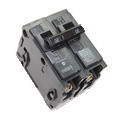Electric Circuit Repair after Flood or Water Damage
 '; ';
|
What should I do about Water Damaged Electrical Wires? Basic Procedure for Water Damaged Electrical Systems, Electrical Repairs for Water Damaged Electrical Wiring and Parts. © By: Dave Rongey |
Basement Water Causes Electric Circuit Problem
Electrical Question: What should I do about water damaged electrical wires?
I had a couple of inches of water in my basement and following the draining of the water I have an electrical circuit that does not work. None of the circuit breakers are tripped and I have tested and reset all the GFCI outlets.
The end of the circuit has lights and outlets that are not getting power but I can’t trace the wires back to the breaker box due to the covering of the drywall.
I had an extension cord plugged into the outlet with the female end laying on the ground when the water flooded and was covering it. No power now reaching that outlet or others connected to it but no tripped breaker. Should I replace the breaker even though it isn’t tripped and seems to flip on and off without any binding?
Is there any other areas I can look to?
This electrical wiring question came from Paul in Michigan.
Dave’s Reply:
Thanks for your electrical wiring question Paul.
Paul, the circuit breaker should be tested to see if it really needs to be replaced. Keep in mind that there may be other damage within the electrical system in the basement that were affected by the water damage. Please continue reading for further information.
Electrical Repairs After Water Damage
- Application: Inspecting and Repairing Water Damaged Electrical Systems.
- Skill Level: Intermediate to Advanced – This is Best performed by a Qualified Electrician or Water Damage Professional.
- Tools Required: Basic Electricians Pouch Hand Tools, Voltage Tester, Continuity Tester and Megger Meter.
- Estimated Time: Depends on the complexity of the water damaged electrical circuits and equipment.
- Precaution: Identify the electrical circuits which provide power to the water damaged area and equipment, turn the circuits OFF and then Tag it with a Note before performing any electrical inspections, tests or repair of electrical wiring.
- Note: Water damaged equipment is best repaired by a Licensed Electrical Contractor or a Certified Trained Water Damage Technician.
- Basic Procedure for Water Damaged Electrical Systems
Water damage can cause a variety of problems not only to the building structure and the furnishings, but also to the electrical wiring system, components and equipment. The electrical circuits should be turned OFF until the water damaged area has been properly evaluated and the necessary repairs have been made. GFCI circuit protection should always be used in the affected area even during the cleanup process where electrical devices and equipment will be used.
- Electrical Repairs for Water Damaged Electrical Wiring and Parts
The affected electrical systems of the water damaged area should be thoroughly inspected. Because of the corrosive damage that can occur, water saturated cable or wiring and electrical components such as outlets and switches should be replaced. If motors or other electrical equipment has become immersed into water or has an accumulation of moisture it would be best to obtain a water corrosion inhibitor that is approved for electrical equipment. Follow the instructions completely which typically suggests to apply the water and corrosion inhibitor before drying the equipment or exposing the equipment to the air. Exposing water damaged equipment to the air without treating it with an approved electrically safe corrosion inhibitor may cause permanent damage.
See More about Home Electrical Wiring Systems
Wiring Electrical Outlets for the Home
Home electrical wiring includes 110 volt outlets and 220 volt outlets and receptacles which are common place in every home. See how wiring electrical outlets for the home are done.
Home Electrical Circuit Wiring
Electrical Circuit Wiring
This article looks at common 120 volt and 240 volt house wiring circuits and the circuit breakers that are installed identifying the types and amperage sizes used in most homes.
Home Electrical Circuit Breakers
Home Electrical Circuit Breakers
A guide to home electrical circuit breakers and how they work to protect your electrical wiring. When properly installed, your home electrical wiring is protected by a circuit protection device.
GFCI and GFI Wiring Diagrams
The features and benefits of GFCI outlets and receptacles will give you a clear understanding of the importance why these safety devices are required by code to help protect you and your family against accidental electrical shock hazards.
GFCI Wiring
This list of articles will help you learn about the features and benefits provided by GFI and GFCI Receptacles and how they are wired.
How to Install Basement Electrical Wiring
Basement Electrical Wiring
Fully Explained Photos and Wiring Diagrams for Basement Electrical Wiring with Code Requirements for most new or remodel projects.
Testers Help Determine Conditions that Lead to Electrical Power Loss
Troubleshooting to Find Out Why Your Home Lost Power
How to Identify Lost Power
Licensed Electrician Reveals the Secrets of Successful Electrical Troubleshooting Methods used to solve the majority of the home electrical problems and wiring failures encountered.
The following may also be helpful for you:
|
|
Be Careful and Be Safe - Never Work on Energized Circuits!
Consult your Local Building Department about Permits and Inspections for all Electric Wiring Projects.
More articles about Electrical Repair and Home Electrical Wiring: |
|
| « Previous | Next » |
How I Install Circuit Breakers in Electrical Service Panels |
How to Wire a JVR Digital Time Switch |

















